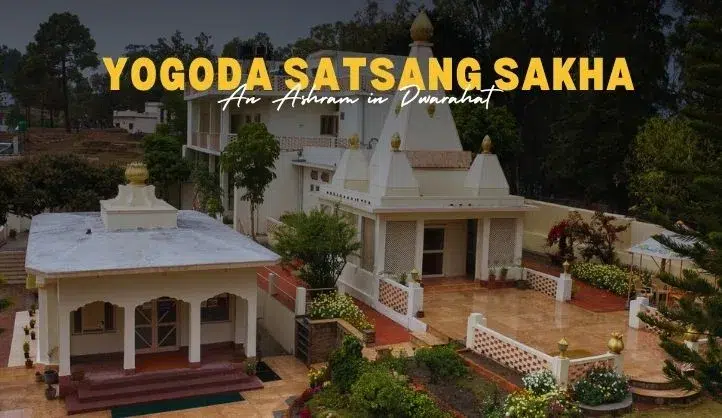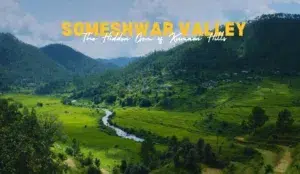Have you ever wanted to visit a peaceful ashram in the Himalayas? Yogoda Satsang Sakha Ashram in Dwarahat, Uttarakhand, is a beautiful spiritual retreat founded by Paramahansa Yogananda, the great yogi who wrote “Autobiography of a Yogi.”
In this guide, you’ll learn:
✔ History of the Ashram
✔ Teachings of Paramahansa Yogananda
✔ How to Visit & What to Expect
✔ Meditation & Spiritual Programs
✔ FAQs for First-Time Visitors
Let’s begin!
The History Behind Yogoda Satsang Sakha Ashram
Who Founded This Ashram?
The ashram was established under the Yogoda Satsanga Society (YSS), founded by Paramahansa Yogananda in 1917. Yogananda, a world-renowned spiritual master, is best known for his book “Autobiography of a Yogi,” which has inspired millions.
Why Was the Dwarahat Ashram Created?
- Located in the Himalayan foothills, Dwarahat was chosen for its pure, vibrationally powerful energy—ideal for deep meditation.
- The ashram follows the principles of Kriya Yoga, a scientific meditation technique taught by Yogananda.
- It serves as a spiritual training centre for monks and devotees.
Did You Know?
Yogananda’s guru, Swami Sri Yukteswar, also had an ashram nearby in Ranikhet, making this region deeply significant for followers of Kriya Yoga.
The Teachings of Paramahansa Yogananda
The ashram follows Yogananda’s core teachings, which include:
A. Kriya Yoga – The Science of Soul-Realisation
- Kriya Yoga is a breath-control technique that accelerates spiritual growth.
- It helps calm the mind and connect with inner divine energy.
- Only initiated disciples can learn the advanced techniques.
B. The Path of Self-Realisation
Yogananda taught that true happiness comes from within. His methods include:
- Meditation (calming the mind)
- Devotional chanting (connecting with divine energy)
- Right living (truthfulness, simplicity, and service)
C. Universal Brotherhood
- The ashram welcomes people of all religions and backgrounds.
- The focus is on inner unity, not external differences.
What to Expect When Visiting the Ashram
A. The Atmosphere – Peaceful & Divine
- Surrounded by lush green hills and fresh mountain air.
- A silent, meditative vibe—perfect for introspection.
- The sound of bells, chanting, and occasional discourses fills the air.
B. Daily Schedule (Typical Routine)
| Time | Activity |
|---|---|
| 5:00 AM | Morning meditation & prayers |
| 7:00 AM | Yoga & Kriya practice |
| 9:00 AM | Breakfast (simple, vegetarian) |
| 11:00 AM | Spiritual discourse/reading |
| 1:00 PM | Lunch (satvik food) |
| 3:00 PM | Free time (rest, walk, read) |
| 5:00 PM | Evening meditation & chanting |
| 7:00 PM | Light dinner |
| 8:30 PM | Night prayers / quiet time |
C. Rules to Follow
- Maintain silence in meditation areas.
- Dress modestly (covered shoulders, no shorts).
- No smoking, alcohol, or non-vegetarian food allowed.
How to Reach Yogoda Satsang Sakha Ashram?
Exact Location
Yogoda Satsang Sakha Ashram
Dwarahat, Almora District, Uttarakhand – 263653, India
Best Ways to Travel
By Air
The nearest airport is Pantnagar (PGH), approximately 127 km away:
- Regular flights from Delhi
- Taxi services available (approx. ₹2500-3000)
- Travel time: 4-5 hours due to mountain roads
By Train
Kathgodam (KGM) is the nearest railhead (120 km):
- Overnight trains from Delhi (Ranikhet Express)
- Shared taxis available (₹200 per seat)
- Private taxi option (₹2000-2500)
By Road
From major cities:
- Delhi to Dwarahat (400 km): 10-12 hour drive via Nainital
- Dehradun to Dwarahat (300 km): 8-9 hours via Ranikhet
- Kathgodam to Dwarahat (120 km): 4-5 hour mountain drive
Pro Tip: The last stretch (Almora to Dwarahat) has winding mountain roads, so travel during daylight.
Accommodation & Facilities
A. Staying at the Ashram
- Simple, clean rooms are available for devotees.
- Booking in advance is recommended (contact YSS office).
- Donation-based stay (no fixed fee, but contributions help the ashram).
B. Food (Satvik Vegetarian Meals)
- Free meals for visitors (simple, nutritious food).
- No onion, garlic, or spicy food (as per yogic principles).
C. Library & Bookstore
- A spiritual library with books by Yogananda.
- You can buy “Autobiography of a Yogi” and other texts.
Spiritual Activities & Programs
A. Meditation & Kriya Yoga
- Free group meditations (open to all).
- Kriya Yoga initiation (for serious seekers after preliminary training).
B. Satsangs & Discourses
- Weekly spiritual talks by resident monks.
- Bhajans (devotional songs) in the evenings.
C. Special Retreats & Events
- Guru Purnima celebrations (July).
- Paramahansa Yogananda’s birthday events (January).
Why Visitors Love This Ashram
Real Experiences from Devotees
- “The energy here is indescribable—I felt instant peace.”
- “Learning Kriya Yoga changed my life.”
- “The monks are so kind and wise.”
Perfect For:
- Meditation seekers
- Yoga & Kriya enthusiasts
- Those wanting a digital detox
- Readers of Yogananda’s teachings
Nearby Places to Visit
Ranikhet (40 km)
Ranikhet is a peaceful hill station surrounded by pine forests and offers breathtaking views of the Himalayas. It’s home to the famous Jhula Devi Temple, where devotees tie bells as offerings for their wishes. The town also has an army cantonment area and beautiful walking trails perfect for nature lovers.
Jageshwar (65 km)
Jageshwar is an ancient temple town with over 100 stone temples dedicated to Lord Shiva. Nestled in a dense deodar forest, the main Jageshwar Mahadev Temple is still actively worshipped. The serene atmosphere and historical significance make it a must-visit for spiritual seekers.
Kainchi Dham (60 km)
Kainchi Dham is a famous ashram built by Neem Karoli Baba, attracting devotees from around the world. The twin temples here radiate peace, and the surrounding hills and river add to its tranquil vibe. It’s a great place for meditation and quiet reflection.
Binsar Wildlife Sanctuary (50 km)
Binsar is a nature lover’s paradise, offering panoramic views of Himalayan peaks like Nanda Devi. The sanctuary has lush forests, diverse wildlife, and scenic trails. The Zero Point viewpoint provides a stunning 360-degree view of the mountains.
Kausani (70 km)
Known as the “Switzerland of India,” Kausani is famous for its sprawling tea gardens and breathtaking sunrise views over the Himalayas. Gandhi stayed here and wrote about its beauty. The Anasakti Ashram commemorates his visit and offers a peaceful retreat.
Dunagiri (25 km)
Dunagiri is a sacred mountain with deep spiritual significance. It’s believed to be the place where Hanuman found the magical herb to revive Lakshmana. The area has small caves where monks meditate, and the views of the valley are mesmerizing.
Almora (35 km)
Almora is a vibrant hill town with bustling markets, ancient temples, and colonial-era architecture. The Nanda Devi Temple and Bright End Corner are popular spots. It’s also a great place to shop for local handicrafts and woolens.
Chitai Temple (35 km)
Chitai Temple is dedicated to Golu Devta, the local deity of justice. The temple is covered with thousands of bells tied by devotees whose wishes were fulfilled. The unique sight and spiritual energy make it a fascinating visit.
Patal Bhuvaneshwar (85 km)
Patal Bhuvaneshwar is an underground cave temple with naturally formed rock shapes resembling Hindu deities. The mystical atmosphere and ancient legends associated with the cave make it a captivating experience.
Baijnath (55 km)
Baijnath is an ancient temple town on the banks of the Gomti River. The 12th-century Katyuri-style temples are architectural marvels, and the main Shiva temple is still a living place of worship.
Bageshwar (60 km)
Bageshwar is a holy town where the Saryu and Gomti rivers meet. The Bagnath Temple hosts the famous Uttarayani Mela every year, drawing thousands of pilgrims. The scenic riverbanks are perfect for peaceful walks.
Gwaldam (90 km)
Gwaldam is a quiet village surrounded by apple orchards and pine forests. It serves as a starting point for treks to Roopkund and Bedni Bugyal. The fresh mountain air and serene environment make it ideal for relaxation.
Bhowali (75 km)
Bhowali is known as the “Fruit Bowl of Kumaon” for its extensive orchards. The town offers stunning Himalayan views and has a historic TB sanatorium. It’s a great stopover for fresh fruits and peaceful surroundings.
Sitalakhet (50 km)
Sitalakhet is a lesser-known gem with panoramic mountain views. The quiet trails and untouched beauty make it perfect for those seeking solitude and nature.
Katarmal Sun Temple (45 km)
The Katarmal Sun Temple is a rare 9th-century temple dedicated to the sun god. Its unique architecture and peaceful setting make it a hidden treasure for history and spirituality enthusiasts.
Final Thoughts – A Must-Visit Spiritual Haven
The Yogoda Satsang Sakha Ashram in Dwarahat offers more than just a retreat—it provides a living connection to Paramahansa Yogananda’s spiritual legacy. Whether you seek profound meditation experiences, authentic Kriya Yoga training, or simply a respite from worldly distractions, this sacred space in the Himalayan foothills stands ready to facilitate your spiritual journey.
For those called to this path, the ashram’s simple yet powerful environment can serve as a catalyst for genuine inner transformation. As Yogananda himself taught, “The time for knowing God has come,” and places like Dwarahat provide the ideal conditions for this sacred pursuit.
Note: Visitors are encouraged to verify current visiting procedures and any travel restrictions before planning their journey.
FAQs about Yogoda Satsang Sakha Ashram
Q1. Can foreigners visit this ashram?
Yes, people from all countries are welcome.
Q2. Is there WiFi or a mobile network?
Limited connectivity (encourages digital detox).
Q3. Can families with kids visit?
Yes, but children should maintain silence in meditation areas.
Q4. What should I pack?
Warm clothes, a meditation shawl, a notebook, and a torch.





